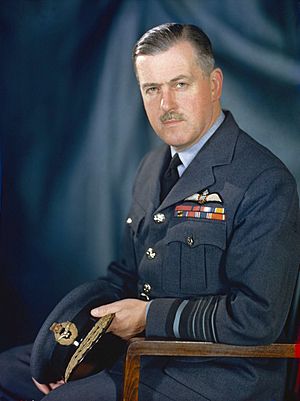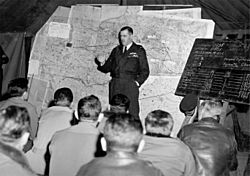Trafford Leigh-Mallory facts for kids
Quick facts for kids
Sir Trafford Leigh-Mallory
|
|
|---|---|

Sir Trafford Leigh-Mallory c.1944
|
|
| Born | 11 July 1892 Mobberley, Cheshire, England |
| Died | 14 November 1944 (aged 52) French Alps |
| Allegiance | United Kingdom |
| Service/ |
British Army (1914–18) Royal Air Force (1918–44) |
| Years of service | 1914–1944 |
| Rank | Air Chief Marshal |
| Commands held | Allied Expeditionary Air Force (1943–44) Fighter Command (1942–43) No. 11 Group (1940–42) No. 12 Group (1937–40) No. 2 Flying Training School (1934–35) School of Army Co-operation (1927–29) No. 8 Squadron (1917–18) No. 15 Squadron (1917) |
| Battles/wars | First World War |
| Awards | Knight Commander of the Order of the Bath Distinguished Service Order & Bar Mentioned in Despatches (3) Commander's Cross with Star of the Order of Polonia Restituta (Poland) Order of Kutuzov, 1st Class (USSR) Chief Commander of the Legion of Merit (United States) |
Sir Trafford Leigh-Mallory (born July 11, 1892 – died November 14, 1944) was a very important leader in the Royal Air Force (RAF). He started as a pilot in the First World War. After the war, he stayed in the RAF, which was a new air force at the time.
During the Second World War, he led No. 12 Fighter Group. Later, he took charge of No. 11 Fighter Group, which protected London during the Battle of Britain. In 1942, he became the head of RAF Fighter Command. In 1943, he was chosen to lead all Allied air forces for the Invasion of Normandy, also known as D-Day.
Sadly, in November 1944, Leigh-Mallory and his wife died in a plane crash in the French Alps. They were on their way to Ceylon for a new job. He was one of the highest-ranking British officers to die in the Second World War.
Contents
Early Life and Education
Trafford Leigh-Mallory was born in Mobberley, England. His father was a church leader. Trafford was the younger brother of George Mallory, a famous mountain climber. He grew up in a big house with many helpers.
He went to Haileybury school and then Magdalene College, Cambridge university. He studied law and planned to become a lawyer. But then, in 1914, the First World War began. Trafford married Doris Sawyer in 1915, and they had two children.
First World War Service
When the war started, Leigh-Mallory joined the army right away. He became an officer in 1914. In 1915, he went to the front lines and was hurt during a battle.
After he got better, he joined the Royal Flying Corps in 1916. This was the air force before the RAF. He learned to fly planes. He flew missions like bombing, scouting, and taking photos during the Battle of the Somme. He later led No. 8 Squadron. His squadron helped tanks and artillery on the ground. For his bravery, he received the Distinguished Service Order.
Between the World Wars
After the First World War, Leigh-Mallory decided to stay in the new Royal Air Force. He continued to rise through the ranks. He became a wing commander in 1925.
He became an expert in how air forces could work with ground armies. He even gave talks about it. In 1937, he was put in charge of No. 12 Group, which was part of Fighter Command.
Second World War Leadership
Leading Fighter Groups
Leigh-Mallory was a strong leader for 12 Group. He was promoted to air vice-marshal in 1938. People said he was very ambitious but always supported his team.
During the Battle of Britain, he had disagreements with another leader, Air Vice-Marshal Keith Park. Park was in charge of defending London. Leigh-Mallory believed in using a "Big Wing" tactic. This was a large group of fighter planes flying together to attack German bombers.
After the Battle of Britain, Leigh-Mallory took over Park's command of 11 Group in December 1940.
Fighter Command and D-Day Planning
Leigh-Mallory was known for being aggressive in his attacks. He sent large groups of fighters into France. These missions were called "rodeos" or "Circus operations" when bombers joined them. However, these raids often led to many RAF planes being lost.
In November 1942, Leigh-Mallory became the head of RAF Fighter Command. He was promoted to air marshal. In 1943, he argued that all Allied air forces should work under one leader for the upcoming invasion of Europe. Many leaders didn't want to give up their power. But Leigh-Mallory's experience in working with the army made him a good choice.
In August 1943, he was chosen to be the commander-in-chief of the Allied Expeditionary Air Force for the Normandy invasion. This meant he was in charge of all the air support for D-Day.
His air plan aimed to stop the German army from moving easily. This meant bombing roads and bridges, even if it affected French towns. He believed these sacrifices were necessary for the plan to work. His plan was successful in slowing down the German army. General Bernard Montgomery was very happy with Leigh-Mallory's air support. He said Leigh-Mallory was the only airman who truly wanted to win the ground battle.
His Death and Legacy
On August 16, 1944, after the Battle of Normandy was almost over, Leigh-Mallory was given a new job. He was to be the Air Commander-in-Chief for Southeast Asia. But on November 14, his plane crashed in the French Alps. He, his wife, and eight others on board were all killed. An investigation found that bad weather caused the crash. Leigh-Mallory had insisted on flying despite the poor conditions.
He and his wife are buried with the aircrew in Le Rivier d'Allemont, France. In 2004, a small museum was opened near the crash site to remember him. A British steam train was also named Sir Trafford Leigh-Mallory in his honor.
Interests and Hobbies
Leigh-Mallory enjoyed sailing and was a fan of cricket. He was also a very private person. After one of his children got very sick and recovered, he became interested in faith healing. He was a Christian and secretly gave money to charities.
He once said he saw a ghost at Gunby Hall in England. During the war, this old house was going to be torn down for an airfield. Leigh-Mallory stepped in and saved it. Today, it is a historic site open to the public.



